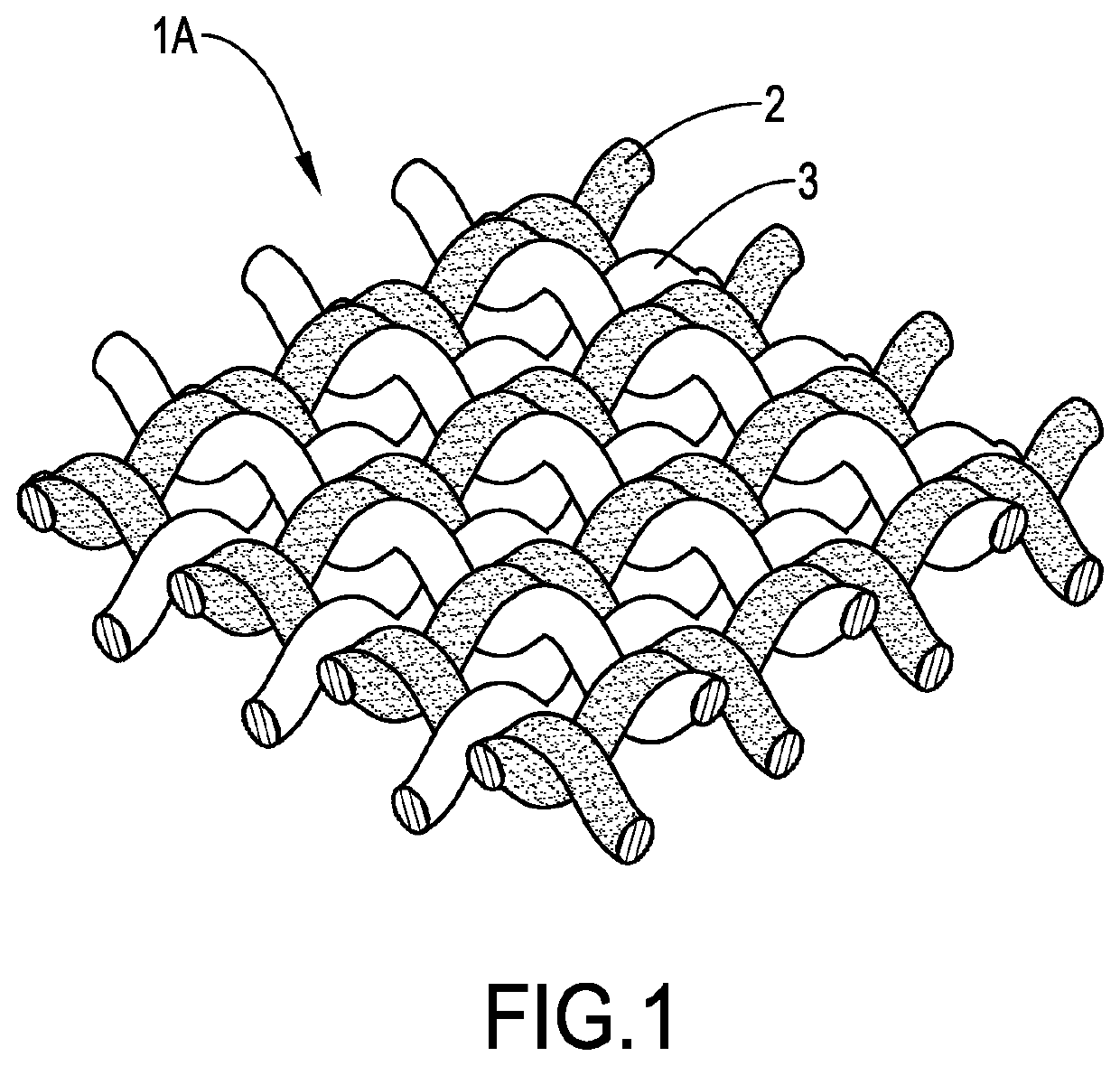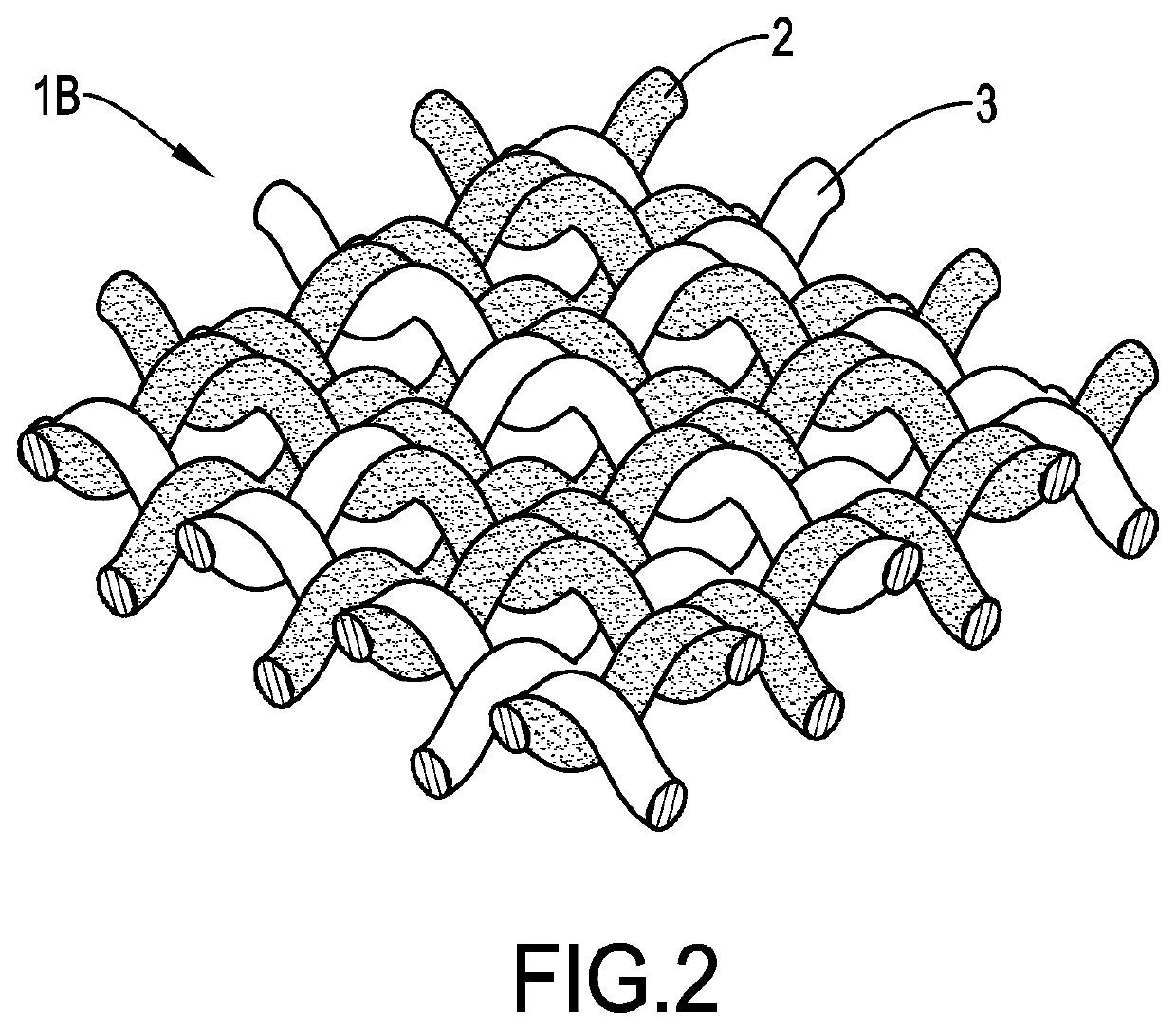Reinforced composite fabric and method for preparing the same
a composite fabric and reinforced technology, applied in the field of textile technology, can solve the problems of ineffective improvement of reinforced effect, long processing time, increased cost, etc., and achieve the effect of simplifying the fabrication process
- Summary
- Abstract
- Description
- Claims
- Application Information
AI Technical Summary
Benefits of technology
Problems solved by technology
Method used
Image
Examples
example 1
[0043]A high-hardness thermoplastic elastomeric (abbreviated as HH-TPE) polymer used in the instant example was thermoplastic polyurethane elastomer (TPU), which had a soft segment and a hard segment at a ratio of 44:56. The soft segment was constructed by polyol and the hard segment was constructed by diisocyanate. The HH-TPE polymer having a shore hardness of 95A and a melting point of 190° C. was melt spun to prepare a HH-TPE yarn (150D / 72F).
[0044]A low-hardness thermoplastic elastomeric (abbreviated as LH-TPE) polymer used in the instant example was TPU and had a soft segment and a hard segment at a ratio of 65:35. The soft segment was constructed by polyol and the hard segment was constructed by diisocyanate. The LH-TPE polymer having a shore hardness of 80A and a melting point of 100° C. was melt spun to prepare a LH-TPE yarn (150D / 72F).
[0045]The HH-TPE yarn and the LH-TPE yarn were crossed upon each other at a ratio of 1:1 to form a woven fabric. The size of the woven fabric ...
example 2
[0047]A HH-TPE yarn (150D / 72F) and a LH-TPE yarn (150D / 72F) used in the instant example were similar with those in Example 1.
[0048]Differently, the HH-TPE yarn and the LH-TPE yarn were crossed upon each other at a ratio of 2:1 to form a woven fabric. The structure of the woven fabric was shown in FIG. 2.
[0049]With reference to FIG. 2, the woven fabric 1B was composed of the HH-TPE yarn 2 and the LH-TPE yarn 3. The warp was composed of the HH-TPE yarn 2 and the LH-TPE yarn 3 at a ratio of 2:1, and the weft was composed of the HH-TPE yarn 2 and the LH-TPE yarn 3 at a ratio of 2:1. That is, two HH-TPE yarns 2 and one LH-TPE yarn 3 were arranged repeatedly in both lateral direction and vertical direction.
[0050]Subsequently, the woven fabric 1B was preheated and hot-pressed as described in Example 1 to form a reinforced composite fabric of Example 2.
example 3
[0051]A HH-TPE polymer used in the instant example was thermoplastic polyether ester elastomer (TPEE), which had a soft segment and a hard segment at a ratio of 37:63. The soft segment was constructed by aliphatic polyester and the hard segment was constructed by aromatic crystal polyester. The HH-TPE polymer having a shore hardness of 72D and a melting point of 220° C. was melt spun to prepare a HH-TPE yarn (150D / 72F).
[0052]A LH-TPE polymer used in the instant example was TPEE, which had a soft segment and a hard segment at a ratio of 62:38. The soft segment was constructed by aliphatic polyester and the hard segment was constructed by aromatic crystal polyester. The LH-TPE polymer having a shore hardness of 30D and a melting point of 150° C. was melt spun to prepare a LH-TPE yarn (150D / 72F).
[0053]The HH-TPE yarn and the LH-TPE yarn were crossed upon each other at a ratio of 1:1 to form a woven fabric similarly as Example 1. Subsequently, the woven fabric was preheated and hot-pres...
PUM
| Property | Measurement | Unit |
|---|---|---|
| melting point | aaaaa | aaaaa |
| melting point | aaaaa | aaaaa |
| melting point | aaaaa | aaaaa |
Abstract
Description
Claims
Application Information
 Login to View More
Login to View More - R&D
- Intellectual Property
- Life Sciences
- Materials
- Tech Scout
- Unparalleled Data Quality
- Higher Quality Content
- 60% Fewer Hallucinations
Browse by: Latest US Patents, China's latest patents, Technical Efficacy Thesaurus, Application Domain, Technology Topic, Popular Technical Reports.
© 2025 PatSnap. All rights reserved.Legal|Privacy policy|Modern Slavery Act Transparency Statement|Sitemap|About US| Contact US: help@patsnap.com


